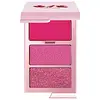What's inside
What's inside
 Key Ingredients
Key Ingredients

 Benefits
Benefits

No benefits
 Concerns
Concerns

 Ingredients Side-by-side
Ingredients Side-by-side

Diisostearyl Malate
EmollientOctyldodecanol
EmollientPolyglyceryl-3 Diisostearate
EmulsifyingPolyethylene
AbrasiveDicalcium Phosphate
AbrasiveMicrocrystalline Wax
Emulsion StabilisingMica
Cosmetic ColorantHydrogenated Microcrystalline Wax
Emulsion StabilisingSynthetic Wax
AbrasivePentaerythrityl Tetra-Di-T-Butyl Hydroxyhydrocinnamate
AntioxidantTin Oxide
AbrasiveCI 77891
Cosmetic ColorantIron Oxides
CI 42090
Cosmetic ColorantCI 15850
Cosmetic ColorantCetyl Dimethicone
EmollientDicaprylyl Carbonate
EmollientCaprylic/Capric Triglyceride
MaskingSilica
AbrasiveDimethicone Crosspolymer
Emulsion StabilisingSynthetic Wax
AbrasiveSynthetic Beeswax
Emulsion StabilisingPolyhydroxystearic Acid
EmulsifyingHdi/Trimethylol Hexyllactone Crosspolymer
Methyl Methacrylate Crosspolymer
Mica
Cosmetic ColorantGlyceryl Caprylate
EmollientTocopheryl Acetate
AntioxidantGlyceryl Undecylenate
EmollientSimethicone
EmollientJasminum Grandiflorum Flower Wax
MaskingLimnanthes Alba Seed Oil
Skin ConditioningSilica Silylate
EmollientCI 77891
Cosmetic ColorantCI 77492
Cosmetic ColorantCI 45410
Cosmetic ColorantCI 15850
Cosmetic ColorantZinc Stearate
Cosmetic ColorantDimethicone
EmollientSodium Dehydroacetate
PreservativeSorbic Acid
PreservativeEthylhexyl Hydroxystearate
EmollientMagnesium Carbonate
AbsorbentOryza Sativa Hull Powder
AbrasivePropylene Glycol
HumectantHylocereus Undatus Fruit Extract
Skin ConditioningPhenoxyethanol
PreservativeCI 42090
Cosmetic ColorantCI 19140
Cosmetic ColorantTalc
AbrasiveTin Oxide
AbrasiveCI 77491
Cosmetic ColorantCetyl Dimethicone, Dicaprylyl Carbonate, Caprylic/Capric Triglyceride, Silica, Dimethicone Crosspolymer, Synthetic Wax, Synthetic Beeswax, Polyhydroxystearic Acid, Hdi/Trimethylol Hexyllactone Crosspolymer, Methyl Methacrylate Crosspolymer, Mica, Glyceryl Caprylate, Tocopheryl Acetate, Glyceryl Undecylenate, Simethicone, Jasminum Grandiflorum Flower Wax, Limnanthes Alba Seed Oil, Silica Silylate, CI 77891, CI 77492, CI 45410, CI 15850, Zinc Stearate, Dimethicone, Sodium Dehydroacetate, Sorbic Acid, Ethylhexyl Hydroxystearate, Magnesium Carbonate, Oryza Sativa Hull Powder, Propylene Glycol, Hylocereus Undatus Fruit Extract, Phenoxyethanol, CI 42090, CI 19140, Talc, Tin Oxide, CI 77491
Ingredients Explained
These ingredients are found in both products.
Ingredients higher up in an ingredient list are typically present in a larger amount.
Ci 15850 is the pigment color red. It is an azo dye and created synthetically.
Azo dyes need to be thoroughly purified before use. This allows them to be more stable and longer-lasting.
This ingredient is common in foundations, lipsticks, and blushes. This color is described as brown/orangey red.
It has many secondary names such as Red 6 and Red 7. According to a manufacturer, Red 6 usually contains aluminum.
Learn more about CI 15850Ci 42090 is a synthetic dye created from petroleum. It is used to give a bright blue color to cosmetics, medicine, and food.
Ci 77891 is a white pigment from Titanium dioxide. It is naturally found in minerals such as rutile and ilmenite.
It's main function is to add a white color to cosmetics. It can also be mixed with other colors to create different shades.
Ci 77891 is commonly found in sunscreens due to its ability to block UV rays.
Learn more about CI 77891Mica is a naturally occurring mineral used to add shimmer and color in cosmetics. It can also help improve the texture of a product or give it an opaque, white/silver color.
Serecite is the name for very fine but ragged grains of mica.
This ingredient is often coated with metal oxides like titanium dioxide. Trace amounts of heavy metals may be found in mica, but these metals are not harmful in our personal products.
Mica has been used since prehistoric times throughout the world. Ancient Egyptian, Indian, Greek, Roman, Aztec, and Chinese civilizations have used mica.
Learn more about MicaSynthetic Wax is created from fossil fuels such as natural gas. It is used to enhance texture, adjust pH, and as an occlusive.
It may also be used as an abrasive ingredient to exfoliate the skin.
Synthetic Wax may not be fungal acne safe.
Learn more about Synthetic WaxTin Oxide is an inorganic oxide used to add opacity and volume to a product. In nature, it is already found in mineral form. The main ore of tin is an opaque and shiny mineral called casseterite.
Tin Oxide helps remove translucency in a product, or make it more opaque. Besides adding opacity, tin oxide is used for bulking to add volume.